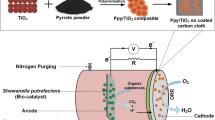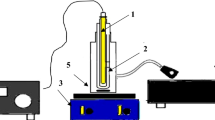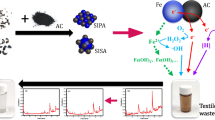Abstract
This study reported that the preparation and characterization of multiwalled carbon nanotubes supported iron phthalocyanine (FePc/MWCNTs) composite catalyst and examined the treatment efficiency using wastepaper recycling mill wastewater in a microbial fuel cell (MFC). The MWCNTs were uniformly decorated over the FePc nano particles. The obtained catalyst was characterized using field emission scanning electron microscopy (FESEM), X-ray diffraction analysis, UV-visible spectrophotometry, energy-dispersive X-ray analysis (EDAX) Fourier-transform infrared spectroscopy (FTIR) analysis, BET analysis, Raman spectra, thermal gravimetric analysis (TGA), and X-ray photoelectron spectroscopy (XPS) analysis. In addition, the oxygen reduction reaction (ORR) of the catalyst has been investigated by cyclic voltammetry, linear sweep voltammetry analysis, and electrochemical impedance spectroscopy (EIS) analysis. There was an efficient removal of chemical oxygen demand (COD) with 87% and 0.650 W/m2 of power density achieved at 110 h of contact time. From this investigation, it is understood that the oxygen reduction reaction (ORR) of the FePc catalyst was improved by MWCNT supporting material. The obtained results suggested the excellent ORR activity of nanostructured FePc/MWCNTs as a promising alternative to conventional platinum-based electro catalyst for fuel cells.











Similar content being viewed by others
References
Birjandi N, Younesi H, Bahramifar N (2016) Treatment of wastewater effluents from paper-recycling plants by coagulation process and optimization of treatment conditions with response surface methodology. Appl Water Sci 6:339–348. https://doi.org/10.1007/s13201-014-0231-5
Tommasi T, Lombardelli G (2017) Energy sustainability of microbial fuel cell (MFC): a case study, J. Power Sources 356:438–447. https://doi.org/10.1016/j.jpowsour.2017.03.122
Rabaey K, Rodríguez J, Blackall LL, Keller J, Gross P, Batstone D, Verstraete W, Nealson KH (2007) Microbial ecology meets electrochemistry: electricity driven and driving communities. International Society for Microbial Ecology journal 1:9–18. https://doi.org/10.1038/ismej.2007.4
Mshoperi E, Fogel R, Limson J (2014) Application of carbon black and iron phthalocyanine composites in bioelectricity production at a brewery wastewater fed microbial fuel cell. Electrochemical Acta 128:311–317. https://doi.org/10.1016/j.electacta.2013.11.016
Huang L, Logan BE (2008) Electricity generation and treatment of wastepaper recycling wastewater using a microbial fuel cell. Appl Microbiol Biotechnol 80:349–355. https://doi.org/10.1007/s00253-008-1546-7
Geetha, K (2013), Integrated distillery wastewater treatment with simultaneous bio-energy production using microbial fuel cell, PhD thesis, Anna University, India.
Zhao N, Jiang Y, Alvarado-Morales M, Treu L, Angelidaki I, Zhang Y (2018) Electricity generation and microbial communities in microbial fuel cell powered by macro algal biomass. Bio Electrochemistry 123:145–149. https://doi.org/10.1016/j.bioelechem.2018.05.002
Mateo S, Cañizares P, Rodrigo MA, Fernández-Morales FJ (2019) Reproducibility and robustness of microbial fuel cells technology. J Power Sources 412:640–647. https://doi.org/10.1016/j.jpowsour.2018.12.007
Gil GC, Chang IS, Kim BH, Kim M, Jang JK, Park HS, Kim HJ (2003) Operational parameters affecting the performance of a mediator-less microbial fuel cell. Biosens Bioelectron 18:327–334. https://doi.org/10.1016/s0956-5663(02)00110-0
Omasta TJ, Wang L, Peng X, Lewis CA, Varcoe JR, Mustain WE (2018) Importance of balancing membrane and electrode water in anion exchange membrane fuel cells, J. Power Sources 375(2018):205–213. https://doi.org/10.1016/j.jpowsour.2017.05.006
Iijima S (1991) Helical micro tubules of graphitic carbon. Nature 354:56–58. https://doi.org/10.1038/354056a0
Hong S, Myung S (2007) Nanotube electronics: a flexible approach to mobility Nat. Nanotechnology 2:207–208. https://doi.org/10.1038/nnano.2007.89
Hutchison JL, Kiselev NA, Krinichnaya EP, Krestinin AV, Loutfy RO, Morawsky AP, Muradyan VE, Obraztsova ED, Sloan J, Terekhov SV, Zakharov DN (2001) Double-walled carbon nanotubes fabricated by a hydrogen arc discharge method. Carbon N Y 39:761–770. https://doi.org/10.1016/S0008-6223(00)00187-1
Chrzanowska J, Hoffman J, Małolepszy A, Mazurkiewicz M, Kowalewski TA, Szymanski Z, Stobinski L (2015) Synthesis of carbon nanotubes by the laser ablation method: effect of laser wavelength. Phys Status Solidi B 252(8):1860–1867. https://doi.org/10.1002/pssb.201451614
Kumar M, Ando Y (2005) Controlling the diameter distribution of carbon nanotubes grown from camphor on a zeolite support. Carbon N Y 43(3):533–540. https://doi.org/10.1016/j.carbon.2004.10.014
Fan S, Chapline MG, Frankline NR et al (1999) Self-oriented regular arrays of carbon nanotubes and their field emission properties. Science 283:512–514. https://doi.org/10.1126/science.283.5401.512
Lee CJ, Son KH, Park J et al (2001) Low temperature growth of vertically aligned carbon nanotubes by thermal chemical vapor deposition. Chem Phys Lett 338:113–117. https://doi.org/10.1063/1.1589187
Bethune DS, Klang CH, de Varies MS et al (1993) Cobalt-catalysed growth of carbon nanotubes with single-atomic layer walls. Nature 363:605–607. https://doi.org/10.1038/363605a0
Dai H, Rinzler AG, Nikolaev P (1996) Single-wall nanotubes produced by metal-catalyzed disproportionation of carbon monoxide. Chem Phys Lett 260:471–475. https://doi.org/10.1016/S1359-0286(97)80014-9
Cao YL, Yang HX, Ai XP, Xiao LF (2003) The mechanism of oxygen reduction on MnO2-catalyzed air cathode in alkaline solution. J Electroanal Chem 557:127–134
Amade R, Vila-Costa M, Hussain S, Casamayor EO, Bertran E (2015) Vertically aligned carbon nanotubes coated with manganese dioxide as cathode material for microbial fuel cells. J Mater Sci 50(3):1214–1221. https://doi.org/10.1007/s10853-014-8677-2
Duteanu N, Erable B, Senthil Kumar SM, Ghangrekar MM, Scott K (2010) Effect of chemically modified Vulcan XC-72R on the performance of air-breathing cathode in a single-chamber microbial fuel cell. Bioresour Technol 101:5250–5255. https://doi.org/10.1016/J.BIORTECH.2010.01.120
Srikanth, S, Pant, D, Dominguez-Benetton, X, Genne, I, Vanbroekhoven, K, Vermeiren, P & Alvarez-Gallego, Y (2016), Gas diffusion electrodes manufactured by casting evaluation as air cathodes for microbial fuel cells (MFC), Materials, pp. 601-608. https://doi.org/10.3390/ma9070601.
Jourdin L, Freguia S, Donose BC, Chen J, Wallace GG, Keller J, Flexer V (2014) A novel carbon nanotube modified scaffold as an efficient biocathode material for improved microbial electrosynthesis. J Mater Chem 2:13093–13102. https://doi.org/10.1039/C4TA03101F
Jasinski R (1964) A new fuel cell cathode catalyst. Nature 201:1212–1213
Zhang L, Liu C, Zhuang L, Li W, Zhou S, Zhang (2009) Manganese dioxide as an alternative cathodic catalyst to platinum in microbial fuel cells. Biosens Bioelectron 24(9):2825–2829. https://doi.org/10.1016/j.bios.2009.02.010
Yu EH, Cheng S, Logan BE, Scott K (2009) Electrochemical reduction of oxygen with iron phthalocyanine in neutral media. J Appl Electrochem 39:705–711. https://doi.org/10.1007/s10800-008-9712-2
Zhao F, Harnisch F, Schroder U, Scholz F, Bogdanoff P, Herrmann I (2005) Application of pyrolysed iron(II) phthalocyanine and CoTMPP based oxygen reduction catalysts as cathode materials in microbial fuel cells. Electrochem Commun 7:1405–1410. https://doi.org/10.1016/j.elecom.2005.09.032
Edwards S, Fogel R, Mtambanegwe K, Togo C, Laubscher R, Limson J (2012) Metallophthalocyanine/carbon nanotube hybrids: extending applications to microbial fuel cells. J Porphyrins Phthalocyanines 16:917–926
Bezerra CWB, Zhang L, Lee K, Liu H, Marques ALB, Marques EP (2008) A review of FeN/C and CoeN/C catalysts for the oxygen reduction reaction. Electrochim Acta 53:4937–4951
Birry L, Mehta P, Jaouen F, Dodelet JP, Guiot SR, Tartakovsky B (2011) Application of iron-based cathode catalysts in a microbial fuel cell. Electrochim Acta 56:1505–1511. https://doi.org/10.1016/j.electacta.2010.08.019
Yuan Y, Ahmed J, Kim S (2011) Polyaniline carbon black composite-supported iron phthalocyanine as an oxygen reduction catalyst for microbial fuel cells. J Power Sources 196:1103–1106. https://doi.org/10.1016/j.jpowsour.2010.08.112
Jiang Z, Yang W, Zhang X, Zheng H, Wang X, Liang Y (2019) Revealing the hidden performance of metal phthalocyanines for CO2 reduction electrocatalysis by hybridization with carbon nanotubes. Anno Research 12(9):2330–2334. https://doi.org/10.1007/s12274-019-2455-z
Chen K, Liu K, An P, Li H, Lin Y, Hu J, Jia C, Junwei F, Li H, Liu H, Lin Z, Li W, Li J, Lu Y-R, Chan T-S, Zhang N, Liu M (2020) Iron phthalocyanine with coordination induced electronic localization to boost oxygen reduction reaction. Nat Commun 11:4173. https://doi.org/10.1038/s41467-020-18062-y
Lens PNL, Pol HL, Wilderer P, Asano T (2002) Water recycling and resource recovery in industry: analysis, technologies and implementation. IWA Publishing, London, p 677
Shah KA, Tali BA (2016) Synthesis of carbon nanotubes by catalytic chemical vapour deposition: a review on carbon sources, catalysts and substrates. Mater Sci Semicond Process 41:67–82. https://doi.org/10.5772/intechopen.86995
Venkatesan S, Visvalingam B, Mannathusamy G, Viswabaskaran Viswanathan A, Rao G (2018) Effect of chemical vapor deposition parameters on the diameter of multi-walled carbon nanotubes. Int Nano Lett 8:297–308. https://doi.org/10.1007/s40089-018-0252-4
By Xiao-Di Wang, K. Vinodgopal and Gui-Ping Dai, (2019) Synthesis of carbon nanotubes by catalytic chemical vapor deposition Published: October 23rd https://doi.org/10.5772/intechopen.86995.
Zhao F, Harnisch F, Uwe Schro¨der, Scholz F, Bogdanoff P, Herrmann I (2005) Application of pyrolysed iron(II) phthalocyanine and CoTMPP based oxygen reduction catalysts as cathode materials in microbial fuel cells. Electrochem Commun 7:1405–1410. https://doi.org/10.1016/j.elecom.2005.09.032
Logan BE, Regan JM (2006) Microbial fuel cells-challenges and applications. Environ Sci Technol 40:5172–5180. https://doi.org/10.1021/es062759
Bard AJ, Faulkner LR (2001) Electrochemical methods: fundamentals and applications, 2nd edn. John Wiley and Sons, New York. isbn:978-0-471-04372-0
Santoro C, Gokhale R, Mecheri B, D’Epifanio A, Licoccia S, Serov A, Artyushkova K, Atanassov P (2017) Design of iron (II) pthalocyanine (FePc) derived oxygen reduction electrocatalysts for high power density microbial fuel cells. Chem Sus Chem 10:3243–3251. https://doi.org/10.1002/cssc.201700851
Kruusenberg I, Matisen L, Tammeveski K (2013) Oxygen electroreduction on multi-walled carbon nanotube supported metal phthalocyanines and porphyrins in acid media. Int J Electrochem Sci 8:1057–1066
Zhang C, Hao R, Yin H, Liu F, Hou Y (2012) Iron phthalocyanine and nitrogen-doped graphene composite as a novel non-precious catalyst for the oxygen reduction reaction. Nanoscale 4:7326–7329. https://doi.org/10.1039/C2NR32612D
Liu S, Jiang X, Zhuo G (2007) In situ chemical formation of iron phthalocyanine (FePc) monolayer on the surface of magnetite nano particles. New J Chem 31:916–920
Zhengping Zhang, Shaoxuan Yang, Meiling Dou, Haijing Liu, Lin Gu & Feng Wang (2016), Systematic study of the transition-metal (Fe, Co, Ni, Cu) phthalocyanine as electrocatalyst for oxygen reduction and its evaluation by DFT, RSC Advances, vol. 6, pp. 67049-67056. https://doi.org/10.1021/am100724v
Tatar B, Demiroglu D (2015) Electrical properties of FePc organic semiconductor thin films obtained by CSP technique for photovoltaic applications. Mater Sci Semicond Process 31:644–650. https://doi.org/10.1016/j.mssp.2014.12.078
Zhang S, Zhang H, Hua X, Chen S (2015) Tailoring molecular architectures of Fe phthalocyanine on nanocarbon supports for high oxygen reduction performance. J Mater Chem A 3:10013–10019. https://doi.org/10.1039/C5TA01400J
Yubin F, Yu J, Zhang Y, Meng Y (2014) Graphite coated with manganese oxide/multiwall carbon nanotubes composites as anodes in marine benthic microbial fuel cells. Appl Surf Sci 317:84–89. https://doi.org/10.1016/j.apsusc.2014.08.044
Mukherjee B (2020) Solvothermally synthesized iron phthalocyanine nanostructure for high ORR response: a joint experimental investigation and DFT analysis. J Electrochem Soc 167:116501. https://doi.org/10.1149/1945-7111/ab9e3a
Arul H, Pak K, Moon U (2018) Metallomacrocyclic-carbon complex: a study of bifunctional electrocatalytic activity for oxygen reduction and oxygen evolution reactions and their lithium-oxygen battery applications. Appl Catal B-Environ 220:288–496. https://doi.org/10.1016/j.apcatb.2017.08.064
Wang X, Wang B, Zhong J, Zhao F, Han N, Huang W, Zeng M, Fan J, Li Y (2016) Iron polyphthalocyanine sheathed multiwalled carbon nanotubes: a high-performance electrocatalyst for oxygen reduction reaction. Nano Res 9(5):1497–1506. https://doi.org/10.1007/s12274-016-1046-5
Baro M, Hussain AA, Pal AR (2014) Enhanced light sensing performance of a hybrid device developed using as-grown vertically aligned multiwalled carbon nanotubes on TCO substrates. RSC Adv 7:46399–47128
Bratashov DN (2012) Potential applications for solar photocatalysis: from environmental remediation to energy conversion. Book on Solar Radiation. https://doi.org/10.5772/34849
Liu Y, Jin X-J, Dionysiou DD, Liu H, Huang Y-M (2015) Homogeneous deposition-assisted synthesis of iron–nitrogen composites on graphene as highly efficient non-precious metal electrocatalysts for microbial fuel cell power generation. J Power Sources 278:773–781. https://doi.org/10.1016/j.jpowsour.2014.12.134
You SJ, Ren NQ, Zhao QL, Wang JY, Yang FL (2009) Power generation and electrochemical analysis of biocathode microbial fuel cell using graphite fiber brush as cathode material. Fuel Cells 5:588–596. https://doi.org/10.1002/fuce.200900023
Yuan G, Zhang G, Zhou Y, Yang F (2015) Synergetic adsorption and catalytic oxidation performance originating from leafy graphite nanosheet anchored iron (II) phthalocyanine nano rods for efficient organic dye degradation. RSC Adv 5:26132–26140. https://doi.org/10.1039/C4RA16530F
Wang X, Wang B, Zhong J, Zhao F, Han N, Huang W, Zeng M, Fan J, Li Y (2016) Iron polyphthalocyanine sheathed multiwalled carbon nanotubes: a high-performance electrocatalyst for oxygen reduction reaction. Nano Res 9(5):1497–1506. https://doi.org/10.1021/ja106217u
Zhu J, Jia N, Yang L, Dong S, Park J, Choi YM, Gong K (2014) Hetero junction nanowires having high activity and stability for the reduction of oxygen: formation by self-assembly of iron phthalocyanine with single walled carbon nanotubes (FePc/SWNTs). J Colloid Interface Sci 419:61–25. https://doi.org/10.1016/j.jcis.2013.12.048
Woo J, Yang SY, Sa YJ, Choi W-Y, Lee M-H, Lee H-W, Shin TJ, Kim T-Y, Joo SH (2018) Promoting oxygen reduction reaction activity of Fe–N/C electrocatalysts by silica-coating-mediated synthesis for anion-exchange membrane fuel cells. Cite this: Chem Mater 30(19):6684–6701. https://doi.org/10.1021/acs.chemmater.8b02117
Praats R, Kaarik M, Kikas A, Kisand V, Jaan Aruv€alic, Paiste P, Merisalu M, Leis J, Sammelselg V, Zagal JH, Holdcroft S, Nakashima N, Tammeveski K (2020) Electrocatalytic oxygen reduction reaction on iron phthalocyanine modified carbide-derived carbon/carbon nanotube composite electrocatalysts. Electrochim Acta 334:135575. https://doi.org/10.1016/j.electacta.2019.135575
Bhowmick GD, Kibena-P˜oldsepp E, Matisen L, Merisalu CM, Kook M, Kaarik M, Leis J, Sammelselg V, Ghangrekar MM, Tammeveski K (2019) Multi-walled carbon nanotube and carbide-derived carbon supported metal phthalocyanines as cathode catalysts for microbial fuel cell applications. Sustain Energy Fuels 3:3525–3537. https://doi.org/10.1039/C9SE00574A
Hao E, Yu S, Scotta CK, BruceLogan (2009) Microbial fuel cell performance with non-Pt cathode catalysts. J Power Sources 171(2):275–281. https://doi.org/10.1016/j.jpowsour.2007.07.010
Mani V, Ezhil Vilian AT, Chen S-M (2012) Graphene oxide dispersed carbon nanotube and iron phthalocyanine composite modified electrode for the electrocatalytic determination of hydrazine. Int J Electrochem Sci 7:12774–12785
Erbay C, Pu X, Choi WCM-J, Ryu Y, Hou H, Lin F, Figueiredo P, Yu C, Han A (2015) Control of geometrical properties of carbon nanotube electrodes towards high-performance microbial fuel cells. J Power Sources 280:347–354. https://doi.org/10.1016/j.jpowsour.2015.08.021
Yuan Y, Zhao SKB, Jeon Y, Zhong S, Zhou S (2011) Iron phthalocyanine supported on amino-functionalised multiwalled carbon nanotubes as an alternative cathode catalyst in microbial fuel cell. Bioresour Technol 102:5849–5854. https://doi.org/10.1016/j.biortech.2011.02.115
Zaid NAM, Idris NH (2016) Enhanced capacitance of hybrid layered graphene/nickel nanocomposite for super capacitors. Sci Rep 6:32082–32090. https://doi.org/10.1038/srep32082
Lu WY, Li N, Chen WX, Yao YY (2009) The role of multi walled carbon nanotubes in enhancing the catalytic activity of cobalt tetra amino phthalocyanine for oxidation of conjugated dyes. Carbon 47:3337–3345. https://doi.org/10.1016/j.carbon.2009.07.055
BaitaoLi XZ, XiujunWang BL, BaikunLi (2014) Hybrid binuclear-cobalt-phthalocyanine as oxygen reduction reaction catalyst in single chamber microbial fuel cells. J Power Sources 272:320–327. https://doi.org/10.1016/j.biortech.2015.05.111
Author information
Authors and Affiliations
Corresponding author
Additional information
Publisher’s Note
Springer Nature remains neutral with regard to jurisdictional claims in published maps and institutional affiliations.
Rights and permissions
About this article
Cite this article
Radha, M., Kanmani, S., Pushpa, T.B. et al. Synthesis and characterization of MWCNT-supported iron phthalocyanine catalyst for the treatment of wastepaper recycling mill wastewater using microbial fuel cell. Biomass Conv. Bioref. 12, 5269–5281 (2022). https://doi.org/10.1007/s13399-021-01331-1
Received:
Revised:
Accepted:
Published:
Issue Date:
DOI: https://doi.org/10.1007/s13399-021-01331-1




